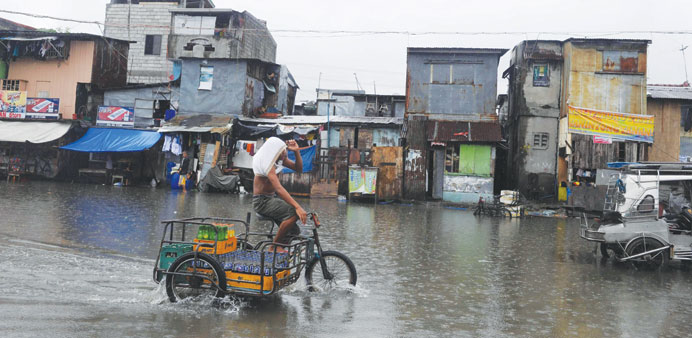|
More than 10,000 people were stranded at ports and some 1,600 evacuated from their homes during a tropical storm in the Philippines overnight, the Office of Civil Defence said yesterday. |
Storm Rumbia (Gorio) slammed into the country on Saturday, with winds of up to 65 kilometres per hour (kph) and gusts of up to 89 kph.
Ferry services were grounded in the central and eastern provinces, the agency said.
The weather bureau said the storm had been due to hit Manila, but changed course. It was expected to dissipate early today.
Earlier, the tropical storm neither caused death nor injuries in areas it hit over the weekend, something that disaster mitigation officials said was a “record first” in recent history. National Disaster Risk Reduction and Management Council (NDRRMC) Executive Director Eduardo del Rosario said that Gorio was the first cyclone that inflicted no casualties in provinces it ravaged.
“I think this is the first time that we have a zero casualty whenever a tropical storm hit our country. This is the first time,” he said.
Del Rosario, who is also the concurrent administrator of the Office of Civil Defence (OCD) attributed the zero casualty to the preparations made by various local government units and the NDRRMC as well as the accurate forecasting of the Philippine Atmospheric Geophysical and Astronomical Services Administration (Pagasa).
“Pagasa was very accurate in their forecasting which is why we were able to give early forecast and warnings to places where the storm will be passing,” he added. In Malacanang, Palace deputy spokesman Abigail Valte said that the Department of Social Welfare and Development (DSWD) has set aside P137.78mn worth of emergency relief resources consisting of standby funds and some 39,959 family food packs, other food and non-food items for the National Capital Region and the Caraga Region.
The DSWD, Philippine Coast Guard, the Metro Manila Development Authority (MMDA) and the NDRRMC were alerted days before “Gorio” made landfall, she added
Valte said that President Benigno Aquino is satisfied with disaster preparations.
The storm made landfall on Saturday in Samar. It packed a maximum sustained winds of 65 kilometre per hour (kph) near the centre and gustiness of up to 80kph.
According to Del Rosario, the storm caused minimal damage to properties and infrastructure, although it left several towns in eastern Samar without power, triggered a landslide in Biliran province and washed away a Vietnam-registered ship in Bicol.
The storm caused floodings in Metro Manila that subsided yesterday morning.
The storm affected 2,309 families or 11,691 people in Region 5 and stranded 9,439 passengers in Bicol and eastern Visayas.
Metro Manila was spared from threats of massive flooding as the storm changed course and headed towards the sea.
However, yesterday remained a wet day for metro residents as it rained overnight and light rain continued over many parts of the city.
Pagasa Acting Administrator Vicente Malano said Gorio was initially projected to affect northern Metro Manila but affected the south instead.
Metropolitan Manila Development Authority chairman Francis Tolentino said that some areas in Metro Manila were hit by the flood.
Nearly 12,0000 people from five towns in Albay province were evacuated on Saturday during the onslaught of typhoon Gorio.
The NDRRMC identified the towns as Santo Domingo, Libon, Oas, Pio Duran and Jovellar where 11,691 people (2,309 families) were evacuated to centres and safe holding areas.
The storm also left six towns in Bataan—Samal, Pilar, Orion, Limay, Bagac and Morong—and the City of Balanga, without electricity.

